GLBP Questions
Here you will find answers to Gateway Load Balancing Protocol (GLBP) Questions
If you are not sure about GLBP, please read our GLBP tutorial.
Question 1
Which protocol allows for the automatic selection and simultaneous use of multiple available gateways as well as automatic failover between those gateways?
A. VRRP
B. GLBP
C. IRDP
D. HSRP
Answer: B
Explanation
In HSRP and VRRP, only the primary router is used to forward traffic, others routers must wait for the primary one down before they are used. Also, the bandwidth of the standby (and other) routers are not used and wasted. With GLBP, up to four gateways can be used simultaneously. There is still one virtual IP address in a group, but GLBP can automatically select which router in the group to forward traffic by sending the virtual MAC address of a selected router to that host.
Question 2
Which two statements are true about HSRP, VRRP, and GLBP? (Choose two)
A. GLBP and VRRP allow for MD5 authentication, whereas HSRP does not.
B. HSRP allows for multiple upstream active links being simultaneously used, whereas GLBP does not.
C. GLBP allows for router load balancing of traffic from a network segment without the different host IP configurations required to achieve the same results with HSRP.
D. Unlike HSRP and VRRP, GLBP allows automatic selection and simultaneous use of multiple available gateways.
E. GLBP allows for router load balancing of traffic from a network segment by utilizing the creation of multiple standby groups.
Answer: C D
Question 3
Refer to the exhibit. What is this configuration an example of?
| track 1 interface POS 5/0 ip routing track 2 interface POS 6/0 ip routing interface fastethernet 0/0 glbp 10 weighting 110 lower 95 upper 105 glbp 10 weighting track 1 decrement 10 glbp 10 weighting track 2 decrement 10 glbp 10 forwarder preempt delay minimum 60 |
A. GLBP weighting
B. Default AVF and AVG configuration
C. GLBP MD5 authentication
D. GLBP text authentication
E. GLBP timer manipulation
Answer: A
Explanation
The command “glbp 10 weighting 110 lower 95 upper 105” specifies the initial weighting value (110), the lower (95) and the upper (105) thresholds. Notice that if the weight falls below the lower threshold then the router will not be an Active Virtual Forwarder (AVF) until the weight rises up to the higher threshold.
When the track object fails, the weighting is decremented by the value after the “decrement” keyword. In this case, POS5/0 and POS6/0 are tracked objects and if one of them fails, the weighting is decreased by 10 -> the weighting = 110 – 10 = 100. This value is still higher than the lower value 95 so this router is still the AVF. If both interfaces fail, the weighting will be smaller than the lower value so this router loses the AVF (until both interfaces are up again).
Question 4
Refer to the exhibit. Which four statements accurately describe this GLBP topology? (Choose four)
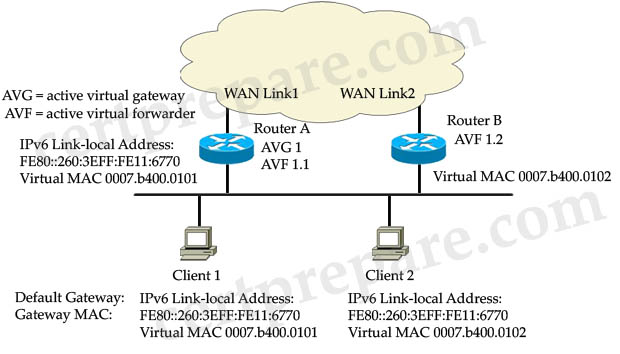
A. Router A is responsible for answering ARP requests sent to the virtual IP address.
B. If Router A becomes unavailable. Router B will forward packets sent to the virtual MAC address of Router A.
C. Router A alternately responds to ARP requests with different virtual MAC addresses.
D. Router B will transition from blocking state to forwarding state when it becomes the AVG.
E. If another router were added to this GLBP group, there would be two backup AVGs.
F. Router B is in GLBP listen state.
Answer: A B C E
Explanation
In a GLBP group, the AVG assigns a virtual MAC address to each member of the GLBP group. It also answers Address Resolution Protocol (ARP) requests for the virtual IP address -> A is correct.
When Router A becomes unavailable, Router B will take over the job of forwarding packets for virtual MAC address 0007.b400.0101 of Router A -> B is correct.
Router A can load balance traffic by alternately responding to ARP requests with different virtual MAC addresses. In this case two virtual MAC addresses 0007.b400.0101 and 0007.b400.0102 will be used alternately in ARP Replies -> C is correct.
Both Router A and Router B are in forwarding state. The trick here is client 1 only sends traffic to Router A while client 2 only sends traffic to Router B -> D is not correct.
If another router were added to this GLBP group, Router B and it can forward packets in the case of Router A fails -> E is correct (but notice that the newly added router would be in listening state).
In GLBP, there are 3 states in a group: active, standby, or listen. Members of a GLBP group elect one gateway to be the Active Virtual Gateway (AVG) for that group. It also elects one member as Standby Virtual Gateway (SVG). If there are more than two members, then the members that remain are in the listen state. In this case, Router A is elected as AVG while Router B is elected as SVG -> Router B is in active state -> F is not correct.
(Reference: http://www.cisco.com/en/US/products/hw/switches/ps708/products_configuration_example09186a00807d2520.shtml)
Question 5
Exhibit:
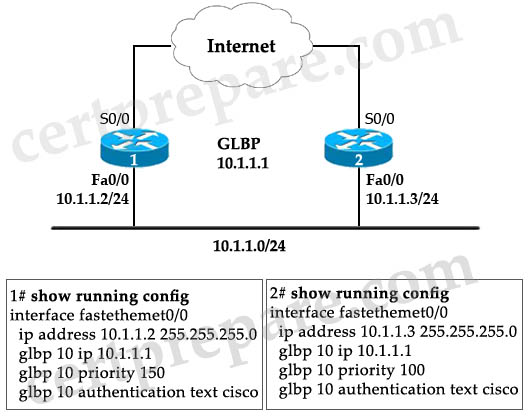
You work as a network engineer at Certprepare.com. You study the exhibit carefully. Which GLBP device hosts receive the MAC address assignment?
A. R1
B. R2
C. The AVG
D. The AVF
Answer: D
Explanation
Notice that the MAC address of the AVF is not the physical MAC address of R1 or R2. It is a virtual MAC address used in GLBP and is used by hosts to send traffic to these routers.
Question 6
Refer to the exhibit. Host A has sent an ARP message to the default gateway IP address 10.10.10.1. Which statement is true?
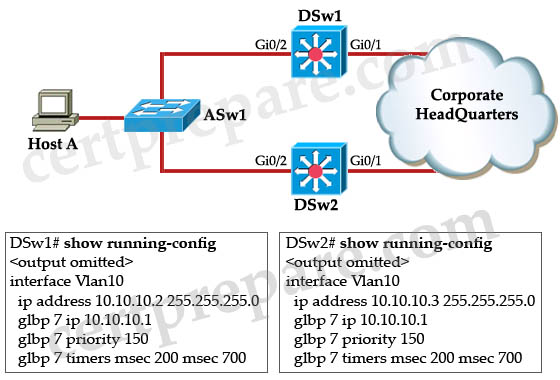
A. DSw2 will reply with the IP address of the next AVF.
B. DSw1 will reply with the MAC address of the next AVF.
C. Because of the invalid timers that are configured, DSw1 will not reply.
D. DSw1 will reply with the IP address of the next AVF.
E. Because of the invalid timers that are configured, DSw2 will not reply.
F. DSw2 will reply with the MAC address of the next AVF.
Answer: F
Explanation
The priorities of two switches are equal so GLBP uses IP address of that interface to choose the AVG -> DSw2 wins the election because of higher real IP address and become the AVG. Therefore it will reply all the incoming ARP Requests with the MAC address of the next AVF (DSw1 and DSw2 alternately in this case.
Question 7
Refer to the exhibit. The Gateway Load Balancing Protocol has been configured on routers R1 and R2, and hosts A and B have been configured as shown. Which statement can be derived from the exhibit?
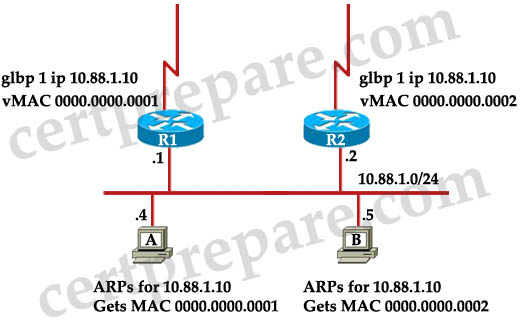
A. The host A default gateway has been configured as 10.88.1.10/24.
B. The GLBP weighted load balancing mode has been configured.
C. The GLBP round-robin, load-balancing mode has been configured.
D. The GLBP host-dependent, load-balancing mode has been configured.
E. The host A default gateway has been configured as 10.88.1.1/24.
F. The host A default gateway has been configured as 10.88.1.4/24.
Answer: A
Question 8
Refer to the exhibit. What is the result of setting GLBP weighting at 105 with lower threshold 90 and upper threshold 100 on this router?
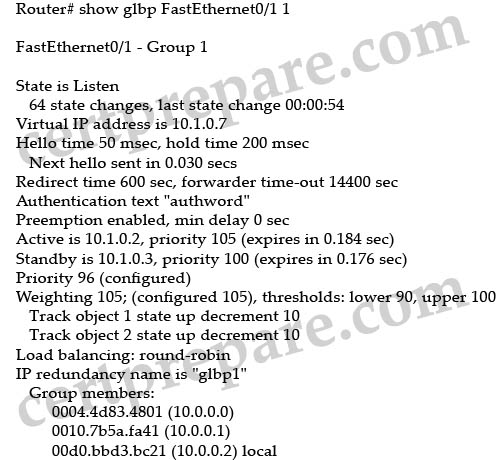
A. Only if both tracked objects are up will this router will be available as an AVF for group 1.
B. Only if the state of both tracked objects goes down will this router release its status as an AVF for group 1.
C. If both tracked objects go down and then one comes up, but the other remains down, this router will be available as an AVF for group 1.
D. This configuration is incorrect and will not have any effect on GLBP operation.
E. If the state of one tracked object goes down then this router will release its status as an AVF for group 1.
Answer: B
Explanation
Each tracked object goes down will decrease the weighting of this router by 10, that makes the weighting = 105 – 10 = 95. This value is still higher than the lower threshold (90) so this router is not lost its status as an AVF. Only if both tracked objects go down, the weighting will fall below the lower threshold (105 – 10 – 10 = 85 < 90) and this router will release its status as an AVF for group 1 -> B is correct.
Question 9
Which describes the default load balancing scheme used by the Gateway Load Balancing Protocol (GLBP)?
A. Per host using a strict priority scheme
B. Per session using a round-robin scheme
C. Per session using a strict priority scheme
D. Per GLBP group using a strict priority scheme
E. Per host basis using a round robin-scheme
F. Per GLBP group using a round-robin scheme
Answer: E
Explanation
In GLBP, there are 3 operational modes for load balancing:
+ Weighted load-balancing: traffic is balanced proportional to a configured weight
+ Host-dependent load-balancing: a host is used the same virtual MAC address as long as that MAC is participating in the GLBP group.
+ Round-robin load-balancing: each virtual MAC is used to respond to each ARP Request alternately. This is also the default load balancing scheme used by GLBP.
Question 10
Refer to the exhibit. GLBP has been configured on the network. When the interface serial0/0/1 on router R1 goes down, how is the traffic coming from Host1 handled?
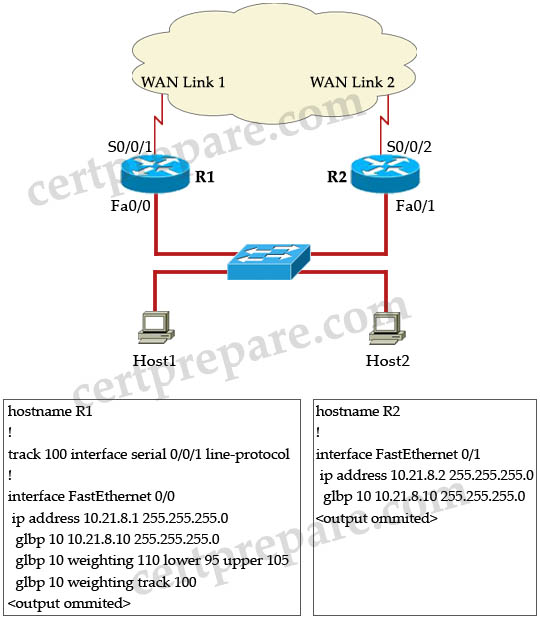
A. The traffic coming from Host2 is forwarded through router R2 with no disruption. The traffic from Host1 is dropped due to the disruption of the load balancing feature configured for the glbp group.
B. The traffic coming from both hosts is temporarily interrupted while the switchover to make R2 active occurs.
C. The traffic coming from Host2 is forwarded through router R2 with no disruption. Host1 sends an ARP request to resolve the MAC address for the new virtual gateway.
D. The traffic coming from Host1 and Host2 is forwarded through router R2 with no disruption.
Answer: D (?)
Explanation
When R1 goes down, the weighting is decreased by 10 by default, priority = 110 – 10 = 100 but it is still higher than the lower threshold (95) so R1 does not give up its role as a virtual forwarder and continues forwarding traffic but the Serial 0/0/1 was down so traffic from Host 1 cannot be routed. Therefore we can’t say answer D is correct.
Maybe there is something wrong in the exhibit. To make answer D correct, the weighting command should be “glbp 10 weighting 100 lower 95 upper 105”.


